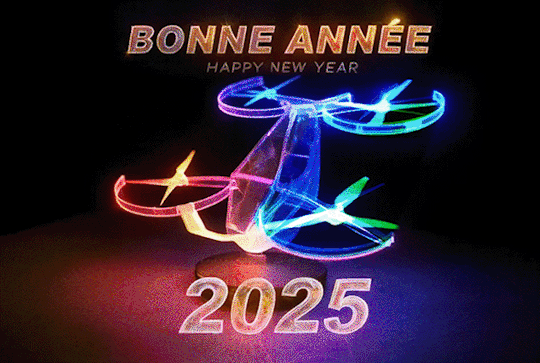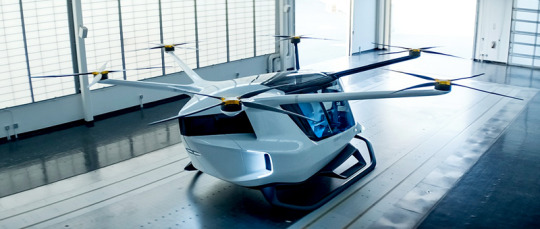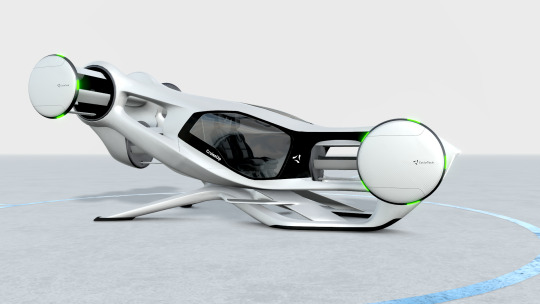#evtol
Explore tagged Tumblr posts
Text







AltoVolo’s hybrid EVTOL "Sigma"
#art#design#flying private#travels#luxury lifestyle#flying palace#jetsetter#jetset#evtol#sigma#hybrid#altovolo#aircraft#billionaire#billionairelife#concept#render#vtol
26 notes
·
View notes
Text
🎉 Happy New Year 2025! 🎉
May this new year be filled with success, creativity, and exciting opportunities. May your projects come to life, your dreams turn into reality, and every moment be an opportunity to grow and thrive.
Thank you for your support and collaboration in 2024. I’m looking forward to sharing new projects with you in 2025!
Wishing you and your loved ones a wonderful year ahead! ✨



3 notes
·
View notes
Text
El sueño de volar
Los sueños de volar algún día se harán realidad con los vehículos aéreos eléctricos de pasajeros. Desde Ícaro desafiando al sol con alas de cera hasta los Wright elevándose sobre Kitty Hawk, la humanidad ha estado obsesionada con surcar los cielos. Ahora, disruptivas startups prometen llevar esa fantasía a nuestras ciudades con taxis aéreos autónomos. Pero mientras visionarios como Lilium y Joby Aviation buscan que despeguemos hacia los suburbios, los autos eléctricos terrestres como los de Tesla ya recorren velozmente las carreteras. ¿Podrán los vehículos voladores personales sortear obstáculos regulatorios y de infraestructura para materializar su potencial? ¿O el futuro de la movilidad eléctrica seguirá atado al asfalto? Revisemos el panorama.

Los humanos han soñado con volar desde la antigüedad. Los primeros esfuerzos se centraron en emular el vuelo de las aves con alas artificiales. En el siglo IX, Abbas Ibn Firnas construyó unas alas rudimentarias y se lanzó desde una torre, planeando brevemente. En el Renacimiento, Leonardo Da Vinci diseñó varios prototipos de máquinas voladoras. Pero no fue hasta finales del siglo XVIII que los hermanos Montgolfier inventaron el globo aerostático, demostrando por primera vez que el vuelo era posible.
A mediados del siglo XIX, Sir George Cayley sentó las bases de la aerodinámica moderna al identificar las cuatro fuerzas que actúan sobre un avión. A principios del siglo 20, los inventores comenzaron a experimentar con autos voladores y aeronaves híbridas tierra-aire. En 1903, los hermanos Wright lograron el primer vuelo propulsado y controlado en un avión más pesado que el aire. La Primera Guerra Mundial vio grandes avances en el diseño de aviones. En 1917, Glenn Curtiss desarrolló el Autoplane, considerado uno de los primeros diseños viables de un auto volador. En 1927, Charles Lindbergh cruzó el Atlántico en un vuelo transoceánico sin escalas.
En la década de 1930, Waldo Waterman creó varios prototipos exitosos de autos voladores que realizaron breves vuelos. Después, la Segunda Guerra Mundial trajo aviones a reacción y cohetes. Sin embargo, la tecnología y los materiales de la época limitaron el desarrollo en gran escala. La Segunda Guerra Mundial y la Guerra Fría desviaron los recursos e intereses hacia jets de combate y cohetes. No fue hasta la década de 1950 que nuevos intentos como el ConvAirCar Model 118 y el Aerocar Aero-Plane tuvieron algo de éxito, aunque eran complejos de operar. En 1969 el Apolo 11 aterrizó en la luna.
En la década de 1980, la Administración Federal de Aviación de EE. UU. estableció estándares de seguridad para vehículos de despegue y aterrizaje vertical. Esto renovó el interés y allanó el camino para desarrollos posteriores. Modelos notables de fines del siglo XX fueron el Avcen Jet Flying Car y el Moller Skycar M400. Sin embargo, los altos costos, la compleja logística y las limitaciones persistentes de almacenamiento de energía evitaron una adopción generalizada.

Ahora en las dos primeras décadas del siglo 21 hemos visto grandes avances en vehículos aéreos eléctricos para transporte urbano y regional. Compañías como Lilium, Joby Aviation y Archer Aviation están desarrollando taxis aéreos y vehículos de despegue y aterrizaje vertical eléctricos (eVTOLs) para viajes punto a punto más rápidos y sostenibles.
En 2006, el avión transitable PAL-V Liberty obtuvo la certificación de la Unión Europea para operar tanto en carreteras como en cielos. Otros como Terrafugia Transition están siguiendo un enfoque híbrido terra-aire. Mientras tanto, AeroMobil ha presentado prototipos de automóviles voladores de alta velocidad para 4 pasajeros.
China ha establecido una hoja de ruta ambiciosa para tener vehículos aéreos operativos masivamente en 2025. Compañías respaldadas como EHang ya tienen taxis aéreos autónomos funcionando en pruebas. Por otro lado, AirBus, Hyundai y Uber planean lanzar servicios aéreos urbanos en la próxima década. Con la electrificación, la autonomía y las asociaciones intersectoriales, es probable que veamos los vehículos voladores tripulados convertirse en una realidad común en los próximos años.
La compañía alemana Volocopter tiene el volador eléctrico Volocity, diseñado para trasladar 2 pasajeros sobre el entorno urbano sin necesidad de infraestructura adicional. Lilium, también alemana, trabaja en una aeronave eléctrica de despegue y aterrizaje vertical capaz de transportar a 4 pasajeros. En Estados Unidos, Joby Aviation construye el taxi aéreo eléctrico S4 con 4 plazas, ideal para entornos suburbanos.

Skai Alaka'i Technologies Hopkinton, Massachusetts, USA. www.skai.co
Se pronostica que este nicho alcanzará 580 mil vehículos anuales en 2040. Empresas como Alaka'i y JetPack Aviation desarrollan prototipos de jets personales compactos impulsados por hidrógeno. La visión futura es que estos vehículos puedan estar al alcance de cualquier persona interesada en experiencias de vuelo personalizadas e innovadoras.
A pesar del entusiasmo por los vehículos aéreos eléctricos de pasajeros, su adopción masiva enfrenta desafíos. Los autos eléctricos terrestres ya tienen una infraestructura establecida de carriles, estaciones de carga y cadenas de suministro. La movilidad aérea urbana, por otro lado, debe resolver complejos rompecabezas regulatorios, de espacio aéreo, ruido y seguridad antes de materializarse.
El futuro de la movilidad aérea personalizada está despegando. Con innovadores vehículos eléctricos de despegue y aterrizaje vertical que transportan de 1 a 4 pasajeros, empresas visionarias lideran una revolución silenciosa y sostenible. Libres como pájaros, pronto cruzaremos ciudades abarrotadas pilotando nuestros propios taxis aéreos. El cielo es el límite para esta nueva era dorada de aviación personal.
¡Agárrate!
Gracias por leerme y compartir
@ptorresmx

2 notes
·
View notes
Text
Крыло-трансформер: будущее дизайна eVTOL
Канадский стартап «New Horizon Aircraft» поставил на крыло свой гибридный eVTOL «Cavorite X7». В воздух был поднят беспилотный прототип электрического «самолёта». Хотя, «Cavorite X7» всё-таки не самолёт. Это нечто среднее, именно eVTOL, где сочетаются самолётные элементы и «квадрокоптерные». А главным ноу-хау становится «крыло-трансформер». И, похоже, что эта схема станет одной из самых…
0 notes
Text
0 notes
Text
#ElectricAirTaxi#UrbanAirMobility#eVTOL#SustainableTransport#AerospaceInnovation#FutureOfMobility#electricvehiclesnews#evtimes#autoevtimes#evbusines
0 notes
Text
AltoVolo is a New Sleek eVTOL Aircraft
Sigma Takes Flight: A Sleek Leap Toward the Skies London startup AltoVolo just unveiled the Sigma, a hybrid-electric eVTOL that looks part spacecraft, part sculpture. With tilting jet propulsion, it uses batteries for lift-off, liquid fuel for range, and ambition for everything in between. Projected to fly 510 miles, cruise at 220 mph, and hit 290 mph at full tilt, it does all this while…
0 notes
Text
Embraer se prepara para testar seu carro voador nos céus brasileiros
A Eve Air Mobility, empresa da Embraer dedicada à inovação em mobilidade aérea, está prestes a iniciar uma fase crucial no desenvolvimento de seu carro voador: os testes em voo do eVTOL (veículo elétrico de decolagem e pouso vertical). Primeiros testes aéreos do carro voador estão prestes a decolar A campanha deve começar nos próximos meses e avaliará o desempenho prático da aeronave, verificando…
#aviação elétrica#carro voador#EMBRAER#Eve Air Mobility#eVTOL#mobilidade aérea#tecnologia sustentável
0 notes
Text
Weekly output: American Airlines WiFi, Archer Aviation eVTOL air taxis, Google display-ads antitrust violations

View On WordPress
#AA#air taxi#American Airlines#American Airlines WiFi#Archer Aviation#banner ads#display ads#eVTOL#EWR#Google antitrust#Google display ads#inflight WiFi#LGA#NYC#NYC airports#United Airlines
0 notes
Text
Archer lanza un revolucionario servicio de taxi aéreo eVTOL con United para acceder rápidamente a los aeropuertos de NYC
Archer Aviation, una innovadora compañía de desarrollo de aviones eVTOL ubicada en Santa Clara, California, está impulsando su visión de la movilidad aérea urbana a través de una alianza con United Airlines. Esta colaboración busca establecer una red de taxis aéreos que conecte Manhattan con los principales aeropuertos de Nueva York, incluyendo el Aeropuerto Internacional John F. Kennedy, el…
0 notes
Text







Cyclotech "Blackbird"
#art#design#flying private#travels#luxury lifestyle#jetsetter#jetset#eVTOL#vtol aircraft#vtol#cyclotech#blackbird#cyclorotors
22 notes
·
View notes
Text

Nouveau Kit pour moto

• Nouvelle génération de kit adaptable pour moto. • Système de navigation simplifié. • Moto entre 750cc et 1300cc • Un moteur électrique remplace la roue arrière pour alimenter les turbines électriques. • Chaque turbine a 2 moteurs et 2 hélices connectées qui tournent dans des sens opposés • Vitesse maxi + 280 km/h. • Autonomie 200kms • Bio Fuel + petite batterie pour atterrissage d'urgence • il est conçu pour voler entre 1 m et max 100 m d'altitude...
6 notes
·
View notes
Text
#Osaka_Metro#eVTOL#partnership#mobility#UrbanMobility#Innovation#powerelectronics#powermanagement#powersemiconductor
0 notes
Text
Флипнем до космопорта? Точнее, до аэропорта.
«Флипнем до космопорта?» или до «Космозоо». Ну, до «Космозоо» может когда-нибудь и будет такое. А пока, в Китае, в частности в Шанхае, уже можно будет перемещаться, используя беспилотное воздушное такси. А в качестве «такси» будет машина eVTOL. Время тестирования технологии прошло. Теперь это вполне себе коммерческий сервис, с машинами, которые производятся серийно. Что это за машины, и чуть…
0 notes
Text
İnsansız eVTOL Uçuşu Gerçekleşti: Çinliler "Uçan Araba" Sektörünü de Ele Geçirecek!
Çinli hava taksi şirketi EHang, EH216-S isimli hava taksi aracını İspanya’da test etti. Bu test ile Avrupa, ilk kez bir eVTOL ve uçan araba testine ev sahipliği yapmış oldu. Uzunca bir süredir gündemde olan ancak henüz somut bir şekilde hayatımıza dahil olmayan eVTOL’lar ve uçan arabalarla ilgili önemli bir gelişme yaşandı. Çinli hava taksi şirketi EHang, İspanya’da bir test uçuşu…
0 notes